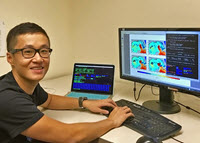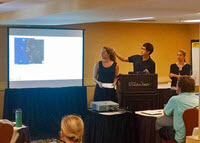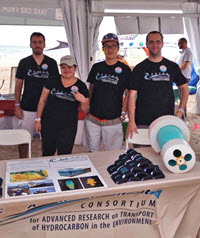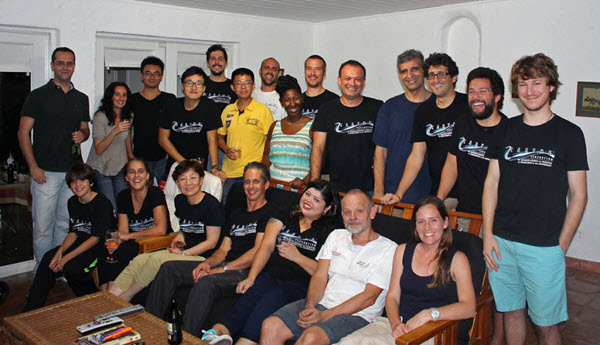
Shitao generates a visualization comparing satellite observational data to model simulations. (Photo by Suzhe Guan)
Researchers use numerical models to simulate oil spill scenarios and predict where oil will go, but the many factors that affect the oil’s path create uncertainty in the predictions. Shitao Wang quantifies the uncertainty of ocean models to gauge the reliability of oil fate predictions. “It’s like a weather prediction. Instead of saying whether or not it will rain tomorrow, forecasters give you an estimation of how likely it is that it will rain tomorrow,” he explained. “While we can’t say for sure that the oil will transport to a certain place, we can say if there is a 10% or even 80% chance.”
Shitao is a Ph.D. student with the University of Miami’s Rosenstiel School of Marine and Atmospheric Science and a GoMRI Scholar with the Consortium for Advanced Research on Transport of Hydrocarbon in the Environment II (CARTHE II).
His Path
Shitao would often watch the sea in his coastal hometown of Qingdao in northeast China. He developed an interest in studying the ocean and enrolled in the Ocean University of China as a marine technology undergraduate student. While completing his bachelor’s degree, he also pursued his interest in computers and incorporated as many computer science classes as possible into his studies. He also spent time in 2010 as an exchange student in Taiwan at I-Shou University’s electrical and information engineering program. “Studying oceanography, especially the modelling aspect of oceanography, is the natural progression of my personal interest and my academic background,” said Shitao.
He applied to the ocean modelling master’s program at the University of Miami in 2012 and joined Dr. Mohamed Iskandarani, who is conducting CARTHE research that improves material transport predictions. Shitao continues his CARTHE research as a Ph.D. student to reduce the margin of error in oil fate predictions.
His Work

Shitao (middle) helped develop a plan for an interactive citizen science website centered on Tampa Bay, including live Q&A sessions with experts during ongoing disasters like sewage runoff or oil spills. (Provided by C-IMAGE)
Uncertainty in ocean models comes from two main sources: the initial conditions (the point at which the model simulation begins) and physical variables such as wind and waves. Shitao uses a technique called ensemble forecasting to quantify uncertainty. He runs the Hybrid Coordinate Ocean Model (HYCOM) under different conditions and analyzes the results to determine the likelihood of certain outcomes, such as for hurricanes or oil spills.
Shitao uses data gathered during the simulation along with Archiving, Validating, and Interpolating Satellite Ocean (AVISO) data to verify and correct the model’s projections. He conducts sensitivity analyses to determine which factors are the principle contributors to the model’s uncertainty. Researchers can use this information to identify which parameters require more attention to improve model output. “This information can inform almost everything related to decision making and helps decision makers assess how they’re going to handle the situation,” he said.
His Learning

Shitao (center right) volunteered at the CARTHE booth during Rock the Ocean’s Tortuga Music Festival in Fort Lauderdale, FL. (Provided by CARTHE)
Shitao’s interactions with other researchers have helped connect him to the bigger picture of his research. Iskandarani’s guidance kept him focused on his work’s purpose when he became engrossed in the details of his research. Shitao felt even more deeply connected to his research as he improved his ability to communicate his work to others. CARTHE All-Hands Meetings and annual Gulf of Mexico Oil Spill and Ecosystem conferences gave him opportunities to communicate with prominent researchers in his field. Student activities and outreach programs taught him the skills to communicate with the public. “These activities connect me to the purpose of my work, and my advisor and fellow researchers connect me to the ‘why’ when the ‘what’ and ‘how’ are insurmountable,” Shitao said.
His Future
Shitao plans to join Uber this fall as a data scientist developing algorithms for improved customer service, leveraging his quantitative background and problem solving abilities. He said, “I am excited to help people move conveniently through the city and improve our community and world by making transportation as reliable as running water – everywhere for everyone.”
Shitao advises students pursuing a scientific career to keep their minds focused on the big picture. He explained that he struggled through the beginning of his research because he focused too much on the details. “The purpose of the research is much more important than the minute details because this is the big driver of your career,” he said. “You have to be able to see the purpose before you dive into the details.”

The CARTHE team at the University of Miami taking a short pause from writing papers to celebrate their successful experiments and publications. (Provided by CARTHE)
Praise for Shitao
Iskandarani said that Shitao is a hard-working and responsible student whose thorough work helped the project make rapid progress quantifying uncertainty in oil plume and ocean model outputs. He noted Shitao’s positive response to criticism as one of his most valuable traits. “Shitao always displayed an open mind about criticism and suggestions, which made his work more rigorous and deepened his understanding of many technical issues,” he said. “In turn, he was very generous with his knowledge and shared with anyone who asked for his help.”
Iskandarani also highlighted Shitao’s friendly and adventurous personality, which over time transformed Shitao’s office into an unofficial meeting place for daily teatimes with his fellow graduate students. He noted that, in contrast to his quieter teatime activities, Shitao is also an avid adventurer and adrenaline seeker. “It worried me to no end when I learned, through a Facebook post, that he went parachuting,” reflected Iskandarani. “I was enormously relieved that he landed safely.”
The GoMRI community embraces bright and dedicated students like Shitao Wang and their important contributions. The GoMRI Scholars Program recognizes graduate students whose work focuses on GoMRI-funded projects and builds community for the next generation of ocean science professionals. Visit the CARTHE website to learn more about their work.
************
The Gulf of Mexico Research Initiative (GoMRI) is a 10-year independent research program established to study the effect, and the potential associated impact, of hydrocarbon releases on the environment and public health, as well as to develop improved spill mitigation, oil detection, characterization and remediation technologies. An independent and academic 20-member Research Board makes the funding and research direction decisions to ensure the intellectual quality, effectiveness and academic independence of the GoMRI research. All research data, findings and publications will be made publicly available. The program was established through a $500 million financial commitment from BP. For more information, visit http://gulfresearchinitiative.org/.
© Copyright 2010- 2017 Gulf of Mexico Research Initiative (GoMRI) – All Rights Reserved. Redistribution is encouraged with acknowledgement to the Gulf of Mexico Research Initiative (GoMRI). Please credit images and/or videos as done in each article. Questions? Contact web-content editor Nilde “Maggie” Dannreuther, Northern Gulf Institute, Mississippi State University (maggied@ngi.msstate.edu).
